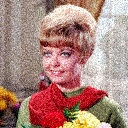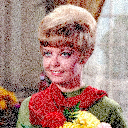-separate -seed 1000 -attenuate 1 +noise gaussian -combine
If you are on an old IM, then -set colorspace RGB is not needed. Also in my alternate at the end after the combine, -colorspace sRGB may not be needed.
On current IM systems, -separate is now making linear gray rather than non-linear gray.
If I do
convert zelda3.png -separate -seed 1000 -attenuate 1 +noise gaussian -combine zelda_gaussian_mono_1e.png
The result is very dark on my IM 6.7.8.1 Q16.
-seed only chooses the seed value for the random number. if you change it, the distribution will be different, that is the noise will be the same but in different places on the image. if you leave it off, then you get different noise distributions each time you run the command.
Test by just creating noise images with different seeds and then alternate the images rapidly. You will see the noise pattern change.
If you do this, you get colored noise.
convert zelda3.png -channel rgb -seed 1000 -attenuate 1 +noise gaussian +channel zelda_gaussian_mono_1f.png
But if you do this, you get monochromatic noise,
convert zelda3.png \
-channel r -seed 1000 -attenuate 1 +noise gaussian \
-channel g -seed 1000 -attenuate 1 +noise gaussian \
-channel b -seed 1000 -attenuate 1 +noise gaussian \
+channel zelda_gaussian_mono_1h.png
but the distribution is different from my earlier forms, namely,
convert zelda3.png -set colorspace RGB -separate -seed 1000 -attenuate 1 +noise gaussian -combine zelda_gaussian_mono_1a.png
and
convert zelda3.png -separate -seed 1000 -attenuate 1 +noise gaussian -combine -colorspace sRGB zelda_gaussian_mono_1d.png
I am not sure why that would be.
Answer from magick:
Its the interlace pattern. For the first command you draw from the random pool in RGB order. First red, then green, then blue. For the first command you draw from the random pool in channel order. We first update the red channel for pixel 1, then the red channel for pixel 2, etc. So we're drawing the same random numbers but applying them in a differ interlace order.

